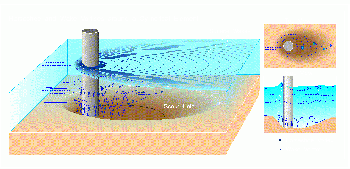Erosion & Scour Mitigation: Difference between revisions
No edit summary |
m (Grichards moved page Scour Analysis to Erosion & Scour Mitigation without leaving a redirect) |
(No difference)
| |
Revision as of 05:07, 17 September 2022

|
| Bridge scour at a cylindrical support (USGS, 2016) |
“Degradation – The long-term process by which streambeds and floodplains are lowered in elevation due to the removal of material from the boundary by flowing water.
“Aggradation – The long-term process by which streambeds and floodplains are raised in elevation due to the deposition of material eroded and transported from other areas.
“Scour – The enlargement of a flow section by the removal of boundary material through the action of fluid motion during a single discharge event. The result of the scouring action may or may not be evident after the passing of the flood event”.[1]
“The two basic factors influencing the extent of degradation in a stream channel are: (1) hydraulic properties including river channel velocities, hydraulic gradient or slope, and depth so flow associated with peak discharges and throughout the range in discharges, and (2) particle size distribution of sediments in the channel bed and banks. A careful evaluation of these factors is essential to any degradation analysis. One additional factor is the combination of streambed and valley controls which may exist in the channel reach subject to degradation. The controls may be rock outcrops, cobbles and boulders in the channel, vegetation growing along the banks, or manmade structures which act to control water levels and retard degradation processes. A control in the channel may in some cases prevent any appreciable degradation from occurring above it. Conversely, a change or removal of an existing control may initiate the degradation process”. [1]
“Before undertaking any degradation study below a dam, an evaluation is needed of the degree of detail required to complete the study, of the appropriate design data for the dam, and of the future environmental conditions below the dam…
“Most existing rivers or streams are in a quasi-equilibrium state when considered on a long-term basis. While in this state, the stream sediment processes of degradation and aggradation are relatively at a standstill and, if occurring, are only of localized nature. The state of stream equilibrium as described by Lan (1955) may be expressed qualitatively by the following equation:
“It is recognized that in some situations other hydraulic parameters may be equally important as slope.
“When any one of the four variables is altered, one or more of the other variables must adjust in order to return the stream to a state of equilibrium. An obvious case is when a dam and reservoir are constructed on a stream, eliminating or diminishing the sediment load downstream from the dam. The relatively clear water released to the stream below the dam is capable of eroding both channel bed and banks when released in sufficient quantity. If the exposed bed and banks are composed of sediment particles that can be moved or picked up by the flowing water, degradation will occur. The degradation process can occur vertically (streambed), laterally (streambanks), or both depending upon the stream discharge and the particle size and cohesive properties of the material forming the bed and banks. In the process of establishing a new state of equilibrium, the stream slope will decrease and the sediment particles remaining in the streambed after some time lapse will be the coarser fraction of the original bed material. Equation 1 provides a comparative evaluation which merely indicates an imbalance in channel equilibrium to be expected and that a change in regimen is imminent. To quantify this change requires application of sediment transport equations either in the form of a mathematical model or in less detail by the empirically tested equations and procedures described in this technical guideline. The effect of this change in regimen below a dam is to produce general degradation and lowering of tailwater elevations”.[1]
Examples
![]()
Best Practices Resources
![]() Computing Degradation and Local Scour
Computing Degradation and Local Scour
Trainings
![]()
Citations:
Revision ID: 3712
Revision Date: 09/17/2022
